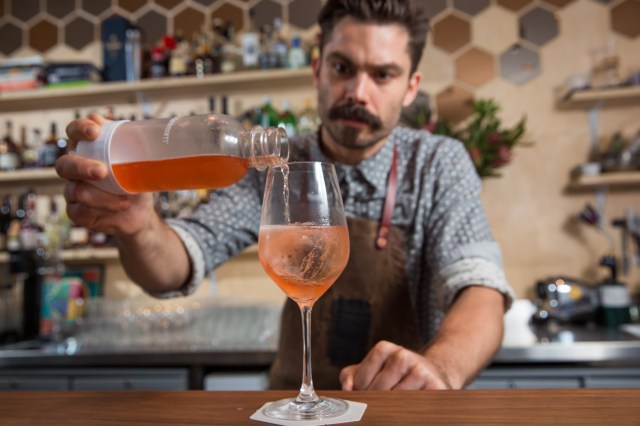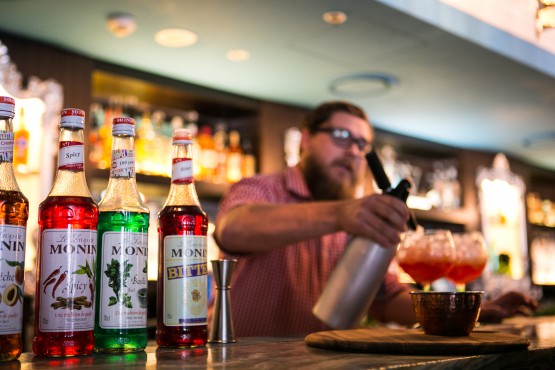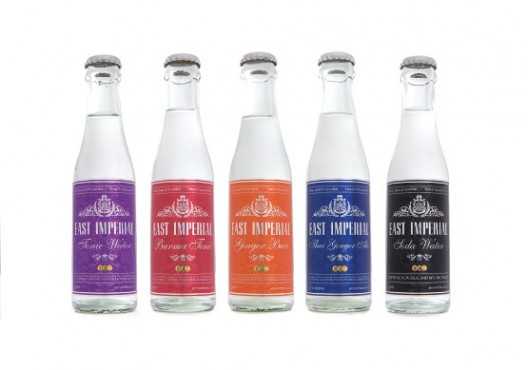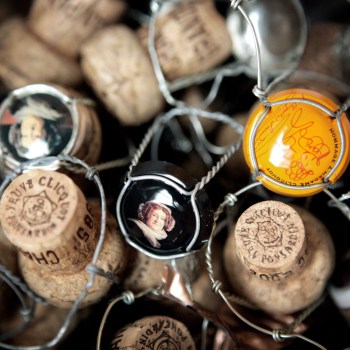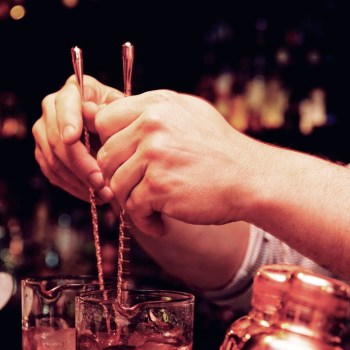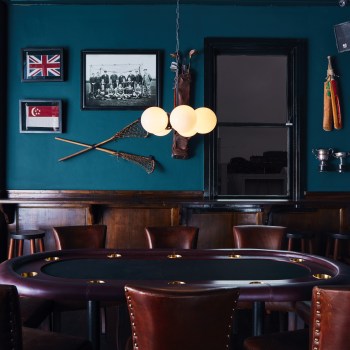Mixers are starting to take centre stage as the category moves towards premium products and craft soda companies begin to come to the fore. So how can you up your mixer game behind the bar? We spoke to those in the non-alcoholic know.
Using a premium mixer when creating mixed drinks and cocktails should be a bit of a no brainer really – any drink is only as good as the quality of its individual parts. Or as Thor Bergquist, bartender and soda enthusiast, points out, the whole thing is going to fall apart.
“My business partner, Michael Chiem, has the best quote for this and I always use it – he says you don’t make your own fresh pasta, use fresh basil and grandma’s pasta sauce to then cook your pasta in dirty seawater,” he says.
Thankfully, it’s a message that seems to be cutting through the background noise, with the proliferation of brands in the craft and premium sectors introducing new flavours, and pushing the stalwarts to keep on top of their game – it’s a win-win for everyone, including consumers.
Bergquist is front and centre of the new wave of mixers. Not only has he been bartending for 12 years, but he and business partner, Chiem, have started a tiny mixer company of their own – kicking off their venture, Pop Soda, by creating a specialist tonic syrup for new distillery on the block, Archie Rose. But it wouldn’t have been possible without the groundwork being laid by other premium brands, leading to an ever increasing range of new flavours and expanded customer awareness.
“I think people have really started ordering tonics and mixers by brand as opposed to asking for a tonic, or a ginger, or a cola,” he says. “And it’s expanded from that, people are really getting on board with different styles of mixers.”
With the growing customer-driven trend for provenance, it is no surprise that the mixers market has been caught up in the push, along with spirits, beer, food, coffee, and basically everything Australians consume. Tony Burt, the co-founder of East Imperial, believes premium mixers are required to enhance, rather than overpower the spirit in a drink.
“The emerging trend of greater focus on heritage, provenance and locally sourced ingredients has influenced the growth in premium mixers,” he says. “Along with this trend is the use of locally sourced botanicals in spirits and mixers that is creating more choices and segmentation along the flavour profiles.”
Angela Barnett, marketing and storytelling at Karma Cola, concurs, adding that health concerns are becoming more apparent among savvy consumers.
“Premium as a category has grown exponentially as customers care more about what they put into their bodies – even with booze,” she says.
That means more people are asking questions about how things are made and they are prepared to pay more for premium products. However, there is more to consider than just where your product ingredients are coming from. As Lewis Kneale, of Little Drippa, points out, bartenders need to be concerned with the consistency of all of the products going into the cocktail.
“Especially when you are dealing with an experienced bar manager creating an amazing cocktail, it is important that the correct mixer is used to give consistency when all of the other staff in that venue make that cocktail,” he says. “There is no point in having the most amazing and complex cocktail on the list if only one person on your team can make it.”
And, according to Matthew Burr, senior category manager for Schweppes, your customers are going to notice, and it will ultimately affect their opinion of your venue.
“When the consumer is paying a premium price for their drink, they have an expectation that the quality will flow right through all of the ingredients,” he says. “Today’s consumer is savvy – they know more about the things they like and want, and have a real desire to explore quality.”
And at the end of the day, better quality sells better, says Tomas Vikario, beverage innovation manager with Monin and Perrier.
“Bars around the country are proud of their range of premium whisky, tequila, mezcal or even craft beers lately, so I don’t see any reason why premium mixers should be left out,” he says. “They have to understand that good mixers will help them to sell more of the premium spirits.”
INVEST IN YOUR TOOLS
While it may seem like an obvious point to make, investing in mixers in the same way that you would invest in quality spirits and good glassware should be a no brainer.
“Just as bars invest in their craft spirits, ice programmes, glassware and tools, bars should invest in quality artisan mixers to compete the experience and create the utmost value for the consumer,” says Burt.
It also doesn’t hurt to learn the stories behind some of the brands – with the aforementioned
provenance trend in mind – as some of them have histories as interesting as the spirits they’re mixed with.
On the subject of spirits, distillers spend years developing the perfect product so it is hardly fair to go and ruin their work with a below-par mixer – which is often the majority of the drink, it has to be said.
“What the on-premise is after is a brand that will allow the consumer to appreciate the spirit and the whole cocktail experience,” says James Johnstone, Fever- Tree brand manager. “If they’ve come into your bar and opted for a top-shelf spirit, go the extra mile for them and suggest a fitting mixer, then watch the smile on their face as they take a sip.”
On a different tack, Kneale points out that price is an important factor that many bars don’t consider when they are looking to buy – especially when it comes to coffee.
“So often I have walked into a venue that has no idea what the cost of the coffee shot is,” he says. “We have a 95 per cent efficiency rate for saving venues money, and often venues are not reducing their total cost but are using the reduction in cost on their mixers to put in more premium spirits.”
It is worth the consideration of doing your sums carefully. The same goes for research. Syrups have been building for a while, with the flexibility and range that allows for plenty of creative expression behind the bar.
“Syrups are an essential ingredient in any successful fresh bar program,” says Vikario. “They elevate the flavours of fresh fruit using small amounts of product and resulting in very clean, fresh and consistent tasting cocktails.”
Simply pair with a premium sparkling water and you’re good to go.
BUILD IT & THEY WILL COME
There are plenty of different theories on how to build a portfolio of anything, be it beer, wine, spirits, etc. However, it is rare that a spirit or another alcoholic beverage would be listed without its brand attached – how often do you read “lager” on a menu with no defining brand name?
“As mixers form the basis of many cocktails, the consumer should be interested in what mixers are being used just as they would the spirit,” says Burr. “Having the brand proudly and clearly on display will go a long way to building the portfolio.”
Likewise, investigate as many different types of flavours and brands as possible – each will taste different with different spirits.
“Look for quality and bottles that will look interesting on your back bar, and get a range across fruit, spice and nuts/herbs – like basil or cola,” says Barnett. “Gather up a range and take them back to the bar and experiment until you find what works.”
And don’t be afraid to get really specific on your menu. Bars like Gin Palace in Melbourne offer specific pairings of gins and branded tonics, each with a particular garnish designed to enhance the experience.
“It’s really about getting your spirits portfolio right for your consumer target and then matching/enhancing the spirits portfolio with the mixer range,” says Burt. “It is very much about creating the story and choices for your customers.”
That said, build your portfolio carefully, look at your customer base and their tastes before making any moves to switch up your range entirely – a variety of price options is always a good idea.
“I think bars should look at what will sell,” says Kneale. “There is no point having great products if your customer won’t buy them.”
INNOVATE OR PERISH
The Australian bar scene is nothing if not innovative, with great bars twisting mixers in unusual ways. The trend towards the Spanish style G&T has led to an array of amazing mixes with garnish chosen specifically to the gin and the mixer. East Imperial’s Imperial Tonic Water is low in sugar (only seven grams per serve) and has only a trace of citric acid, with bartenders experimenting with rum and tequila tonics and even espresso at Singapore’s East Imperial Gin Jubilee.
Coming up on the international scene is also the retro trend of long pink gins (with bitters and East Imperial Burma Tonic). Imperial Dark & Stormy cocktails are also appearing on draught in a few bars, including some in Melbourne.
Grant Collins’ team at The Powder Keg serve Sydney’s only G&T on tap with Fever-Tree tonic, and 1806 in Melbourne does a cocktail degustation, which kicks off with Aperol, sauvignon blanc, rosewater and Fever-Tree soda water.
Longrain in Sydney is serving up A Cherry Bomb using white rum, cranberry juice, Karma Cola and fresh raspberries. While Gingerella is being used as an alternative to the old ‘rum and coke’ – using golden rums, lime and fresh mint.
And at Union Electric, in Melbourne, Gingerella features in the Shotgun Highball alongside golden rum, pineapple syrup and lime curacao. Bartenders are also pushing the limits on coffee in cocktails, with plenty of bars using cold drip in Negronis, old school flips, Old Fashioneds, and even coffee-infused Pina Coladas.
Monin syrups are already being used around the country to create artisan sodas for soda-syphons, while Perrier has long benefited from “sublimation”. Which is simply when a naturally refreshing ingredient (cucumber, ginger, watermelon, mint etc) is combined with Perrier to enhance the essential oils and flavours of the fruit with the bubbles and the minerals.
